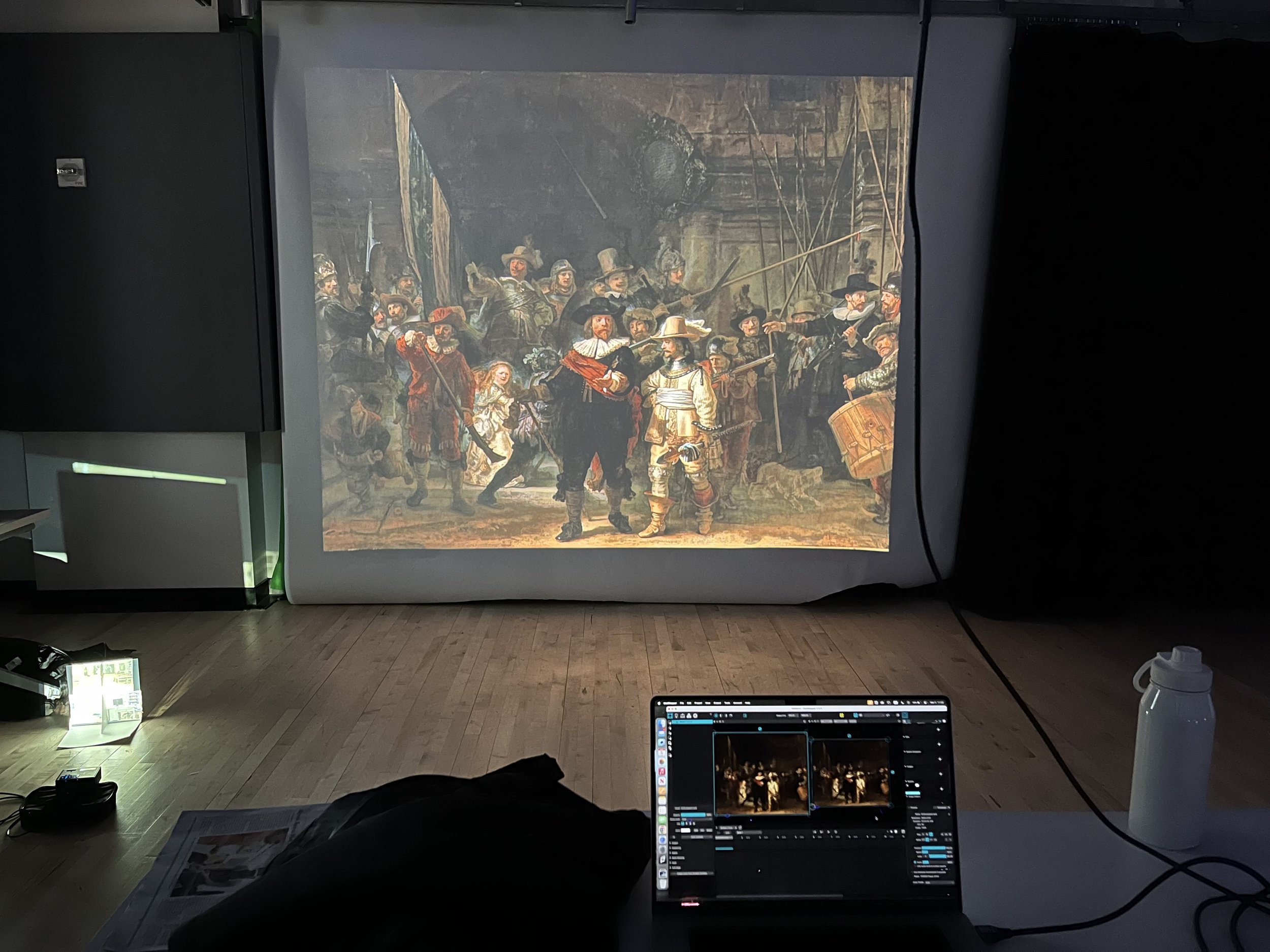MIDTERM - MAP THE ART
Week 07 | 03/05/2024
Concept & Research:
This project, named 1642, brings sound to Rembrandt's painting, The Night Watch. The painting was done in 1642 in Amsterdam, and it is one of the most famous and important paintings in Western art history.
The project will commence by breaking the painting into 4-5 layers. The bottom layer will consist of the architecture in the background, followed by layers representing the people from behind to front. Each person will be digitally represented and painted to showcase the animation of the painting process.
Throughout the painting of the background and layers, as well as the inclusion of intricate details, sound will be playing simultaneously to provide audiences with a more immersive experience. The selected sounds will be sourced from classical music in the late Baroque, Classical, and early Romantic periods, composed by renowned musicians such as Bach, Mozart, Liszt, and others. The sounds will be presented through orchestral, chamber, and solo instruments. Additionally, ambient sounds like passing carts, jewelry making, swinging pikes, firearm actions, and more will be incorporated.
The realization of this project necessitates extensive research into daily life in Amsterdam during the mid-17th century. An in-depth exploration of clothing and attire belonging to different social classes and occupations of that period is crucial, still, as the blocked figures in the back layers will also be accurately depicted. AI images will aid in generating options and ideas for this step.
Ultimately, all 34 characters will be allocated their specific spot, time, music, sound, and unique representation. A script will be written to organize the project, detailing the sequence of each layer, ensuring a harmonious fusion of visuals and sounds. The animation will be projected at a 1:1 scale of the painting, measuring at 11' 11" x 14' 4". It is hoped that this immersive experience will bring the audience a grander, theatrical, and dramatic encounter within the context of the combination of the visual splendor of Rembrandt in Dutch Golden Age and the timeless allure of classical music.
Figma file to the mind map and more info of the project.
Mapping, Installation, and Equipment:
The video was projected onto a white canvas located in one of the Ball Rooms. Ideally, the size of the projection should have matched the 1:1 scale of the painting, which is about 15 feet by 12 feet. However, due to the constraints of the venue's size, achieving this ideal size was not possible. I checked out an Optoma EH412ST projector, a long HDMI cable, an extension arm for the ceiling mount, power cables, and a safety cable. The installation process was straightforward. I also checked out an audio cable to play audio through the integrated speakers in the ballroom, as their audio quality is far superior to that of a laptop or projector.
First, I needed to ensure that the projector was functional. Once that was confirmed, I mounted it on the ceiling and opened MadMapper’s grid to make sure that the horizontal and vertical lines aligned with the edges of the canvas. The graphics could always be fine-tuned in MadMapper.
Reflection:
In this latest iteration, it's the first time I've combined two separate compositions. However, the animation layers of the characters are still progressing from front to back, contrary to the original idea of animating them from back to front. The transition from color to line drawings was executed relatively smoothly, but it lacks some excitement. I think the composition could be lengthened by adding more elements, and more details are needed in the line drawings, such as spikes in the background and the hall. For this version, I haven't yet determined the blocked layers, but they will be depicted by simple line drawings, as explained in the last blog post. Also, I plan to test different camera angles and start moving the camera to make the experience more immersive and dynamic.
Quantitatively, the ideal length of this film is between 10 to 20 minutes, showcasing a thorough process of constructing and composing the painting with the rhythm of various Baroque compositions. However, due to time constraints, I am aiming for a 3-5 minute, tastefully scripted and executed animation as a trailer for the final presentation. In the 10-minute presentation, I can’t just show a video alone — I'll share a lot more information about this project, therefore a trailer seems appropriate.
Qualitatively, the focus is on one word: details. Details are crucial - the precision of each layer's cut with fuzzy edges, the number of layers extracted from the original painting, the timing of each character's appearance, and how each stroke, shadow, and light is represented in sync with the composition's tempo, down to the decaseconds and pixels. If I can impress the audience with a 3-5 minute trailer and make them eager to see the entire piece projected at 1:1 scale (15'x12'), it will greatly motivate me to complete the full piece after graduation. Like good movies, a compelling film about a classic piece takes time to create, prototype, iterate, reiterate, and complete.
The goal of this piece remains unchanged – to pay respect to and celebrate Rembrandt's craftsmanship by presenting this painting in a dynamic and immersive way, while adding my own perspective. I also want to remind people that by looking back, we can rediscover and reinterpret the immense treasure trove of human creations. As a member of the ITP community, we consistently create new things and embrace cutting-edge technologies, which is fantastic. However, I believe there's still great value in revisiting the past.
One insightful piece of feedback from Anvay during the playtest was to move the camera based on the characters’ movements/gestures in the painting. For example, if we zoom in on someone's hand pointing in a direction, we could move the camera accordingly. This creates an indirect interaction between the audience and the painting, even though they can't control the camera.





